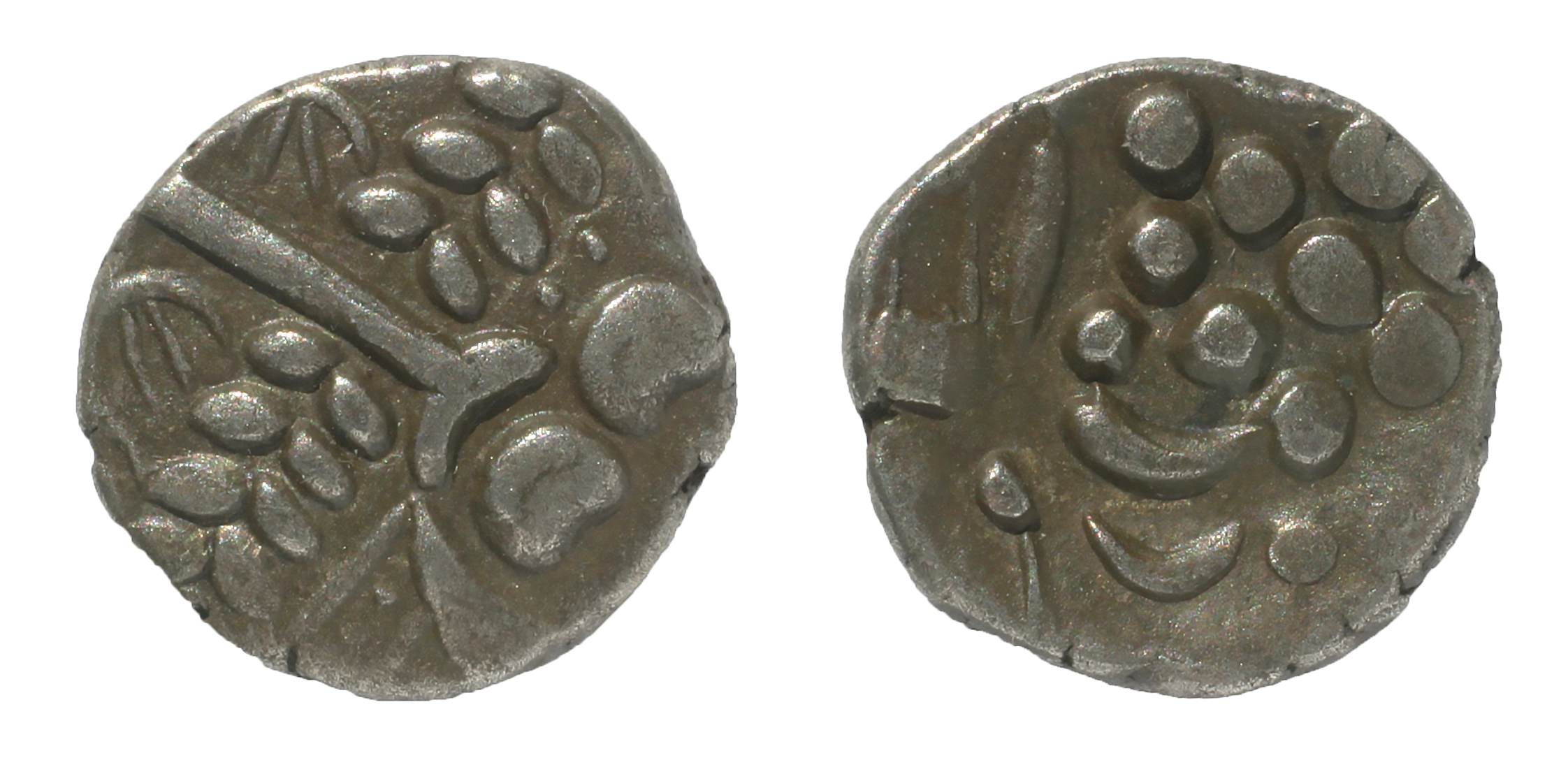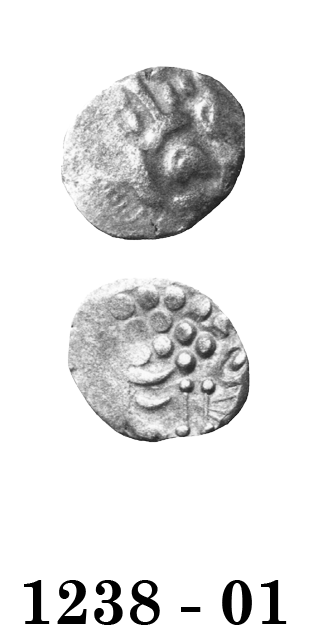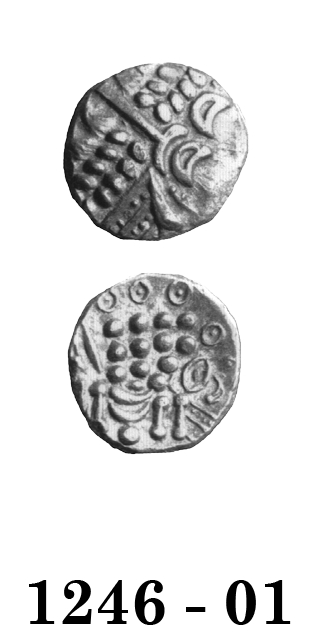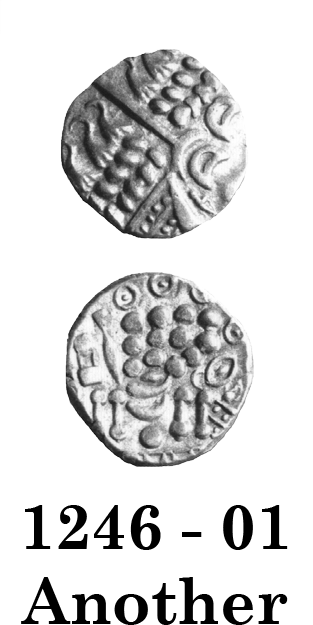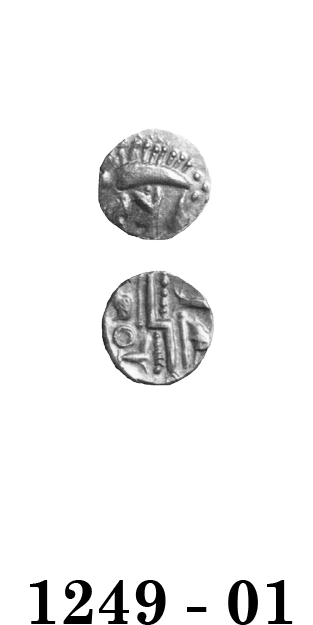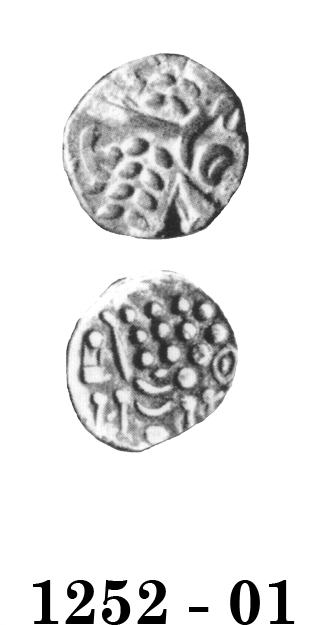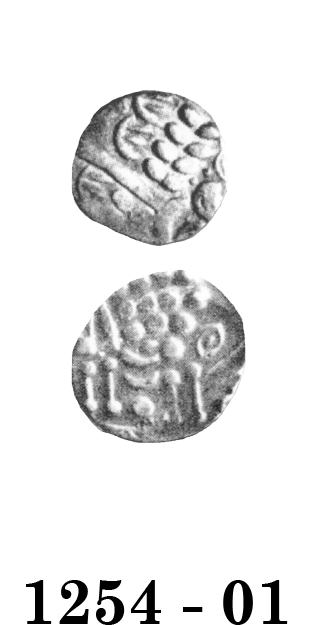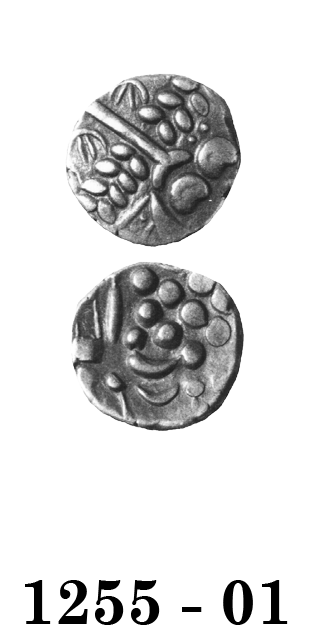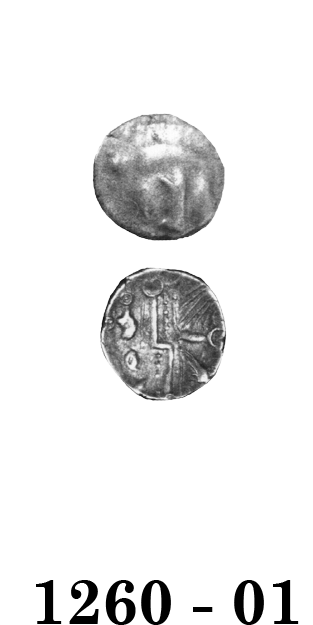
Celtic Coinage of Britain
third edition
Click on coin to see hidden information
Durotrigan White Gold, Silver and Billon Coinages
The transition from gold to silver coins is indistinct. The Quarter staters become white gold, silver and then billon all with no apparent changes in style or privy marks. The silver staters actually begin as white gold coins, but rapidly degrade to silver and finally billon. The billon types have many varieties, some possibly the products of local or irregular mints.
A new series of quarters, the starfish type, is entirely within the billon series. Two major varieties of starfish quarters distinguished by the thickness of the flan, are known. Most of these types are common today, because a hoard of well over 800 pieces was discovered in the vicinity of Badbury Rings hillfort.
The metallurgical and typological sequences of the coins are problematic and the dating uncertain the following treatment is somewhat arbitrary. An alternative interpretation, not used here, is that several mints were striking coins without centralized control.
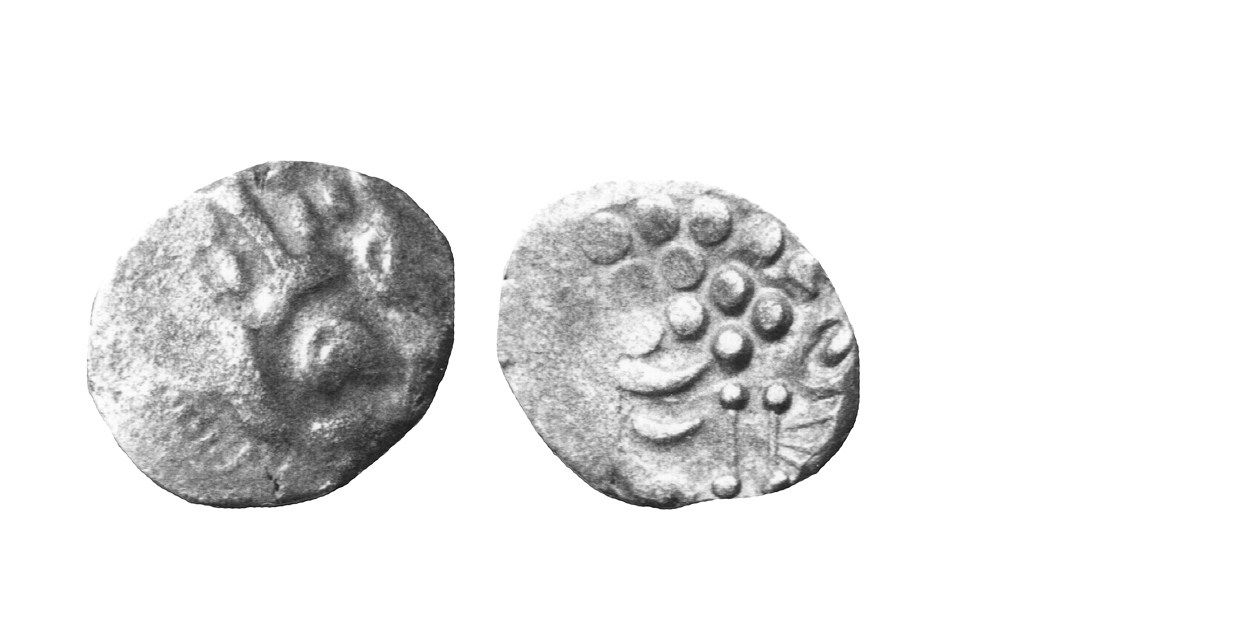
1238 - 01 Spread-Tail Type
58-45 B.C. Very Rare
Billon Stater 4.0-5.6 gms. 20 mm
Earliest Record: Van Arsdell, 1989
OBV: Abstract head or Apollo right
Identifying points:
1) as 1235 - 01
2) sometimes two pellets above curve of spike, but not on all examples
REV: Disjointed horse left
Identifying points:
1) as 1235 - 01 except three strands of tail spread apart as they extend to right
2) sometimes pellets between strands of tail, but not on all examples
CLASSIFICATION: Durotrigan F
NOTES:
- Type may exist in good silver variety
- Sometimes the tail strands meet at a pellet on the left, sometimes not
- Rarity provided by trade survey in 1980s now confirmed by Celtic Coin Index records
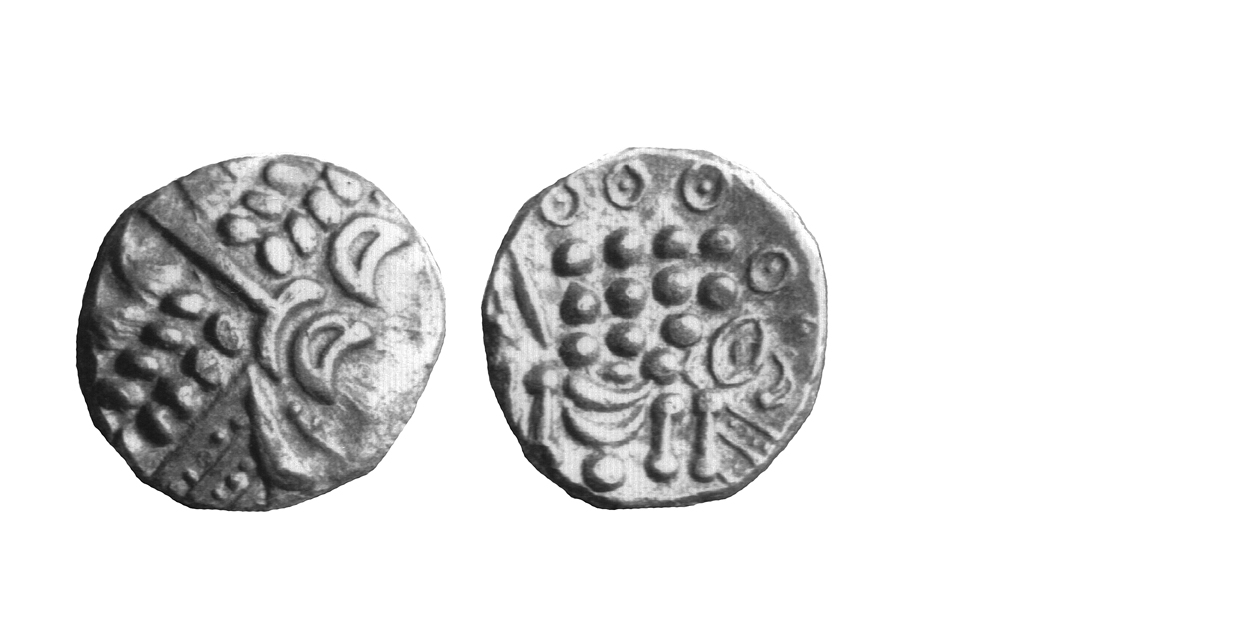
1246 - 01 Pellet and Ring Type
45-40 B.C. Common
Silver or Billon Stater ca. 5.5 gms. 19 mm
Earliest Record: Evans, 1864
OBV: Abstract head of Apollo right
Identifying points:
1) as 1235 - 01, but two pellets below lowest curl of hair
REV: Disjointed horse left
Identifying points:
1) similar to 1235 -01
2) pellet-in-ring motifs above and behind horse
3) tail extends downwards and has pellets between strands
4) crescent to left of coffee bean
5) pellet with two attached crescents to right of coffee bean
CLASSIFICATION: Durotrigan G
NOTES:
- The type was known to Evans, see his plate F2
- One of these coins per every ten Abstract Type Staters appears in hoards, apparently a consistent average
- Rarity provided via trade survey
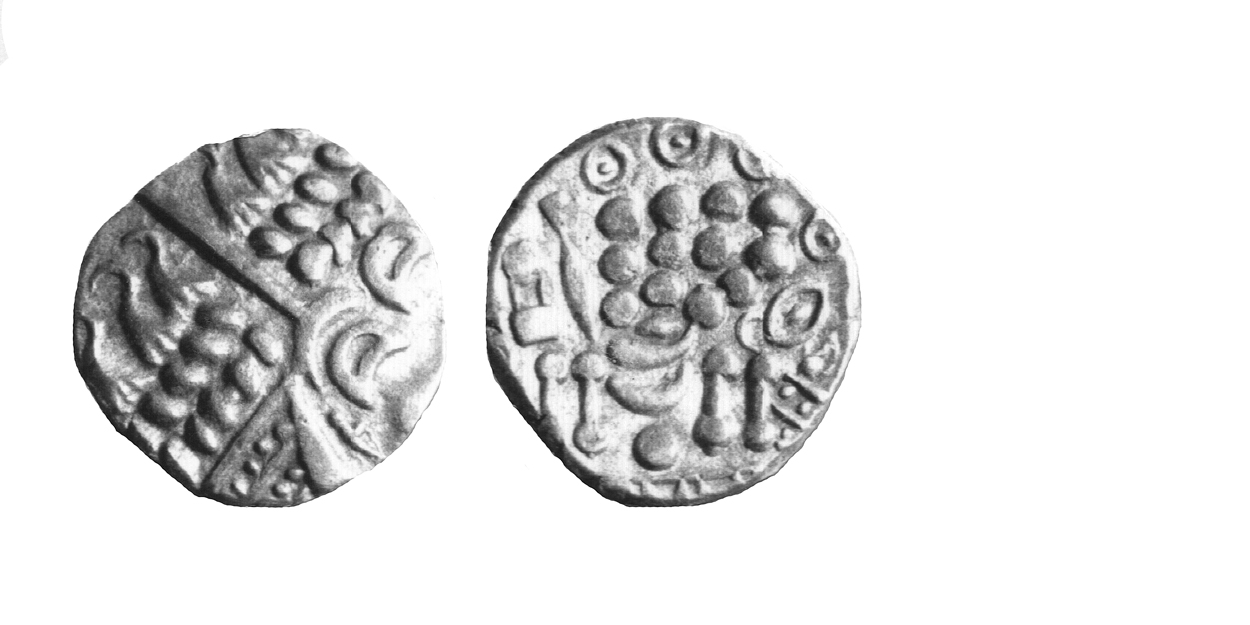
1246 - 01 Pellet and Ring Type
45-40 B.C. Common
Silver or Billon Stater ca. 5.5 gms. 19 mm
Earliest Record: Evans, 1864
OBV: Abstract head of Apollo right
Identifying points:
1) as 1235 - 01, but two pellets below lowest curl of hair
REV: Disjointed horse left
Identifying points:
1) similar to 1235 -01
2) pellet-in-ring motifs above and behind horse
3) tail extends downwards and has pellets between strands
4) crescent to left of coffee bean
5) pellet with two attached crescents to right of coffee bean
CLASSIFICATION: Durotrigan G
NOTES:
- The type was known to Evans, see his plate F2
- One of these coins per every ten Abstract Type Staters appears in hoards, apparently a consistent average
- Rarity provided via trade survey
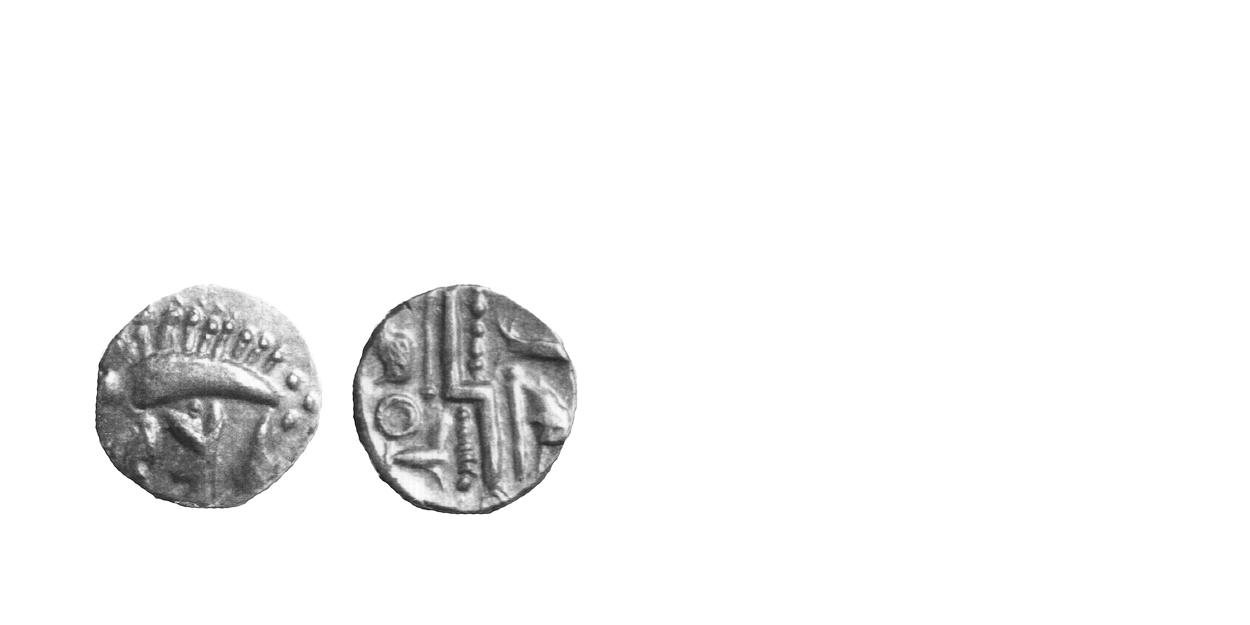
1249 - 01 Second Geometric Type
45-40 B.C. Common
Silver or Billon Quarter Stater 1.2 gms. 11 mm
Earliest Record: Evans, 1890
OBV: Pattern
Identifying points:
1) similar to 1242 - 01, but image is larger and cruder
2) long spikes with pellet-ends above the truncated crescent
REV: Geometric pattern
Identifying points:
1) similar to 1242 - 01 but cruder
2) "bird", irregular six-sided figure and Y-like objects all almost unrecognizable
3) ring added to left of field
4) zigzag decorated with line of pellets
CLASSIFICATION: Durotrigan G
NOTES:
- The long spikes on the obverse may represent hair on a wolf, supporting the "Wolf and Twins" hypothesis (see: Cutting, 1978)
- Orienting the coin up-side-down, the long spikes may represent a boat's oars, supporting the "Boat" hypothesis (see Muret and Chabouillet, 1889, p. 198)
- There is still no certain way to settle the debate regarding the denotation of the image
- Celtic Coin Index records now indicate commoner than previously thought
- Some in museums
- Celtic Coin Index records now indicate commoner than previously thought
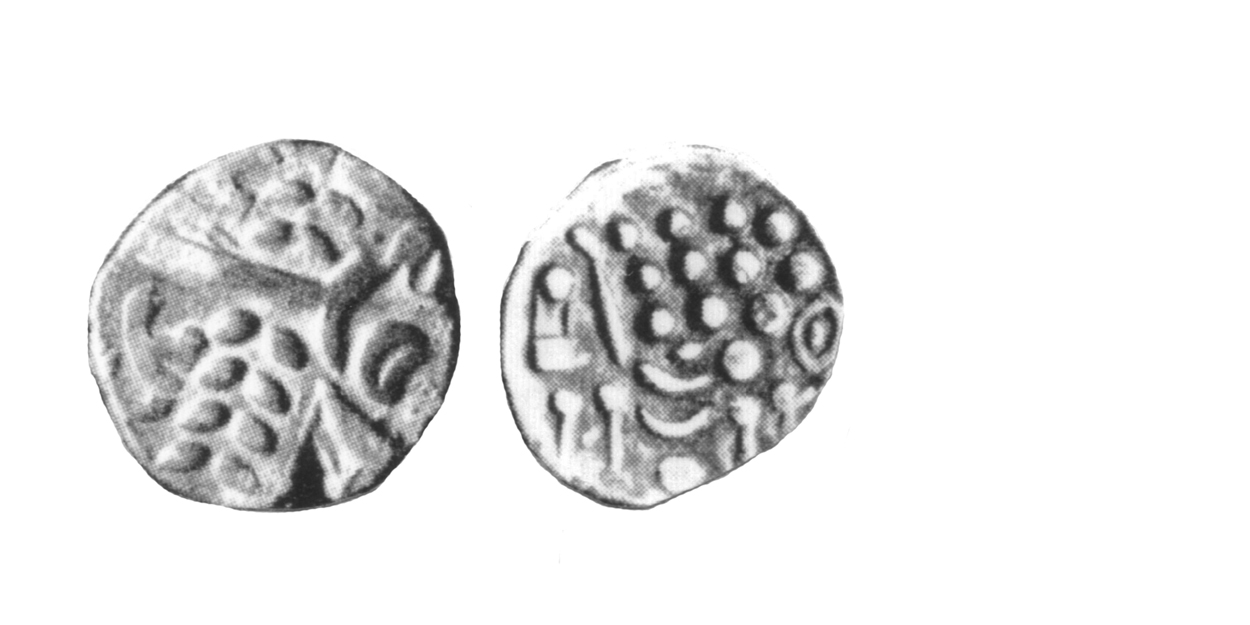
1252 - 01 Two Branch Type
40-35 B.C. Extremely Rare
Billon Stater ca. 4.1 gms. 19 mm
Earliest Record: Van Arsdell, 1989
OBV: Abstract head of Apollo right
Identifying points:
1) similar to 1235 - 01 but head larger and cruder
2) Two pellets above curve of spike
3) hair to left made up of two-branched objects
REV: Disjointed horse left
Identifying points:
1) Similar to 1235 - 01 but horse larger and cruder
CLASSIFICATION: Durotrigan H
NOTES:
- Most in museums
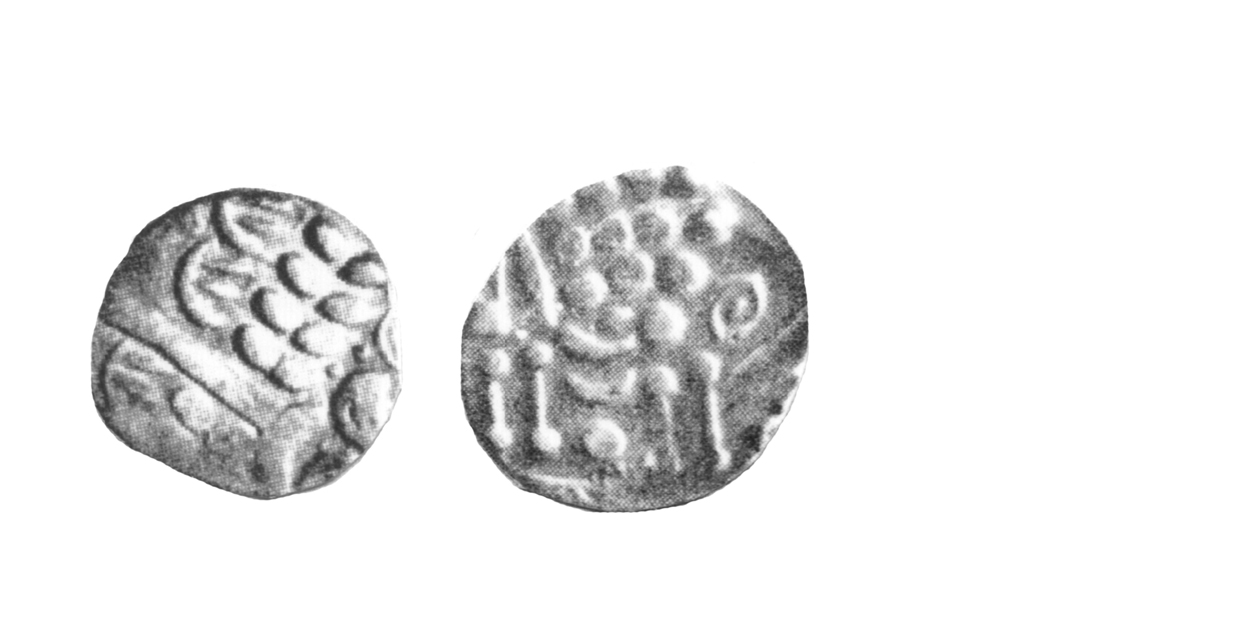
1254 - 01 Three Branch Type
40-35 B.C. Extremely Rare
Billon Stater ca. 4.3 gms. 17 mm
Earliest Record: Van Arsdell, 1989
OBV: Abstract head of Apollo right
Identifying points:
1) similar to 1235 - 01 but head larger and cruder
2) two pellets above curve of spike
3) hair to left made up of three-branched objects
REV: Disjointed horse left
Identifying points:
1) similar to 1235 - 01 but horse larger and cruder
CLASSIFICATION: Durotrigan H
NOTES:
- Most in museums
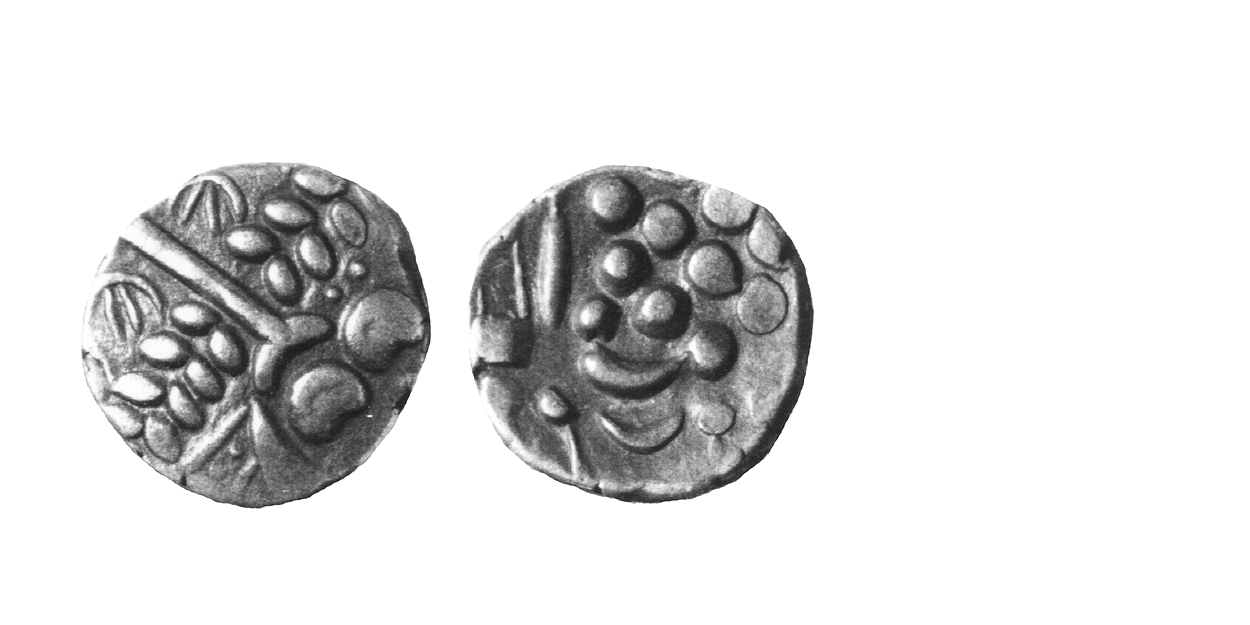
1255 - 01 Four Branch Type
40-35 B.C. Extremely Rare
Billon Stater 4.28 gms. 19 mm
Earliest Record: Van Arsdell, 1989 (Noted at Spink's 1984)
OBV: Abstract head of Apollo right
Identifying points:
1) similar to 1235 - 01 but head larger and cruder
2) two pellets above curve of spike
3) hair to left made up of four-branched objects
REV: Disjointed horse left
Identifying points:
1) similar to 1235 - 01 but horse larger and cruder
CLASSIFlCATlON: Durotrigan H
Notes:
- Weight of existing example given
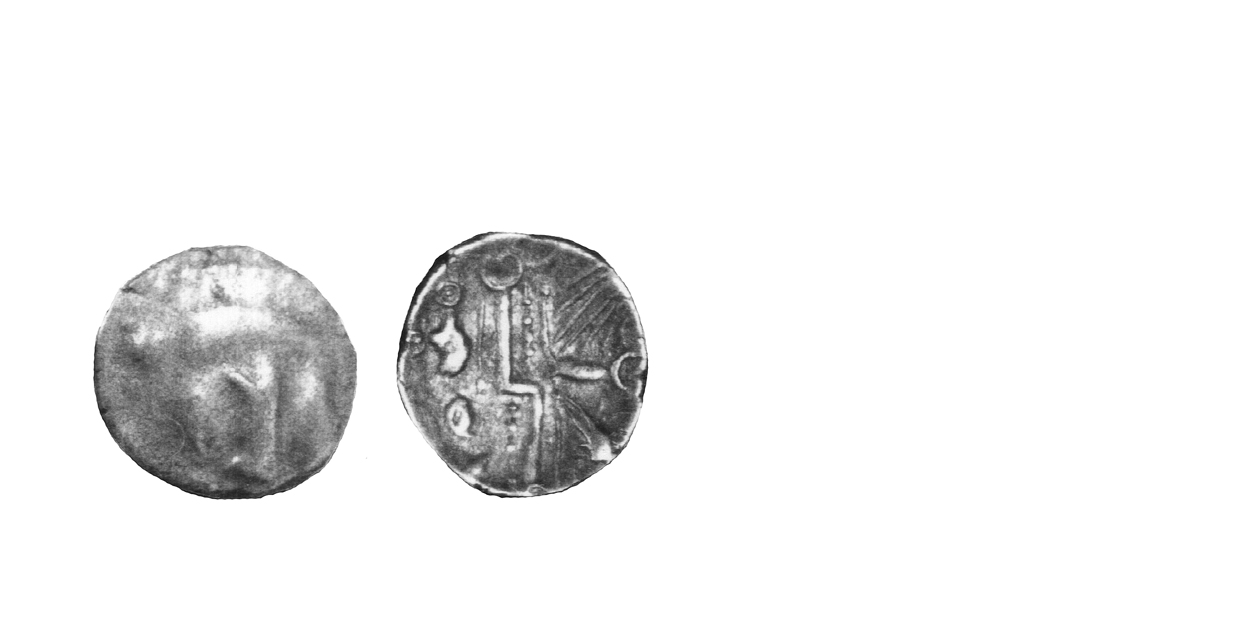
1260 - 01 Third Geometric Type
40-35 B.C. Common
Silver or Billon Quarter Stater 0.8-l.0 gms. 14 mm
Earliest Record: Van Arsdell, 1989
OBV: Pattern, almost plain
Identifying points:
1) as 1249 - 01, but obverse die used until almost obliterated
REV: Geometric Pattern
Identifying points:
1) similar to 1249 - 01 but cruder
2) all objects in field almost unrecognizable
3) "clamshell" object in upper right
CLASSIFICATION: Durotrigan H
NOTES:
- Celtic Coin Index records now indicate commoner than previously thought
The Coinage of the Durotriges
The Durotriges occupied all of Dorset, parts of Somerset, Wiltshire and Hampshire. They had extensive trading contacts with the Armorican peninsula and consequently their coinage was unlike that of the other British tribes. Armorican coins were primarily silver and billon, and the bulk of the Durotrigan coinage was made of these metals instead of gold.
After their first issues, the Durotriges ignored the mainstream of British coinage, suggesting they were economically isolated. Moreover, their coins circulated less and less beyond the tribal boundaries as time went on, and as the tribe's isolation increased.
Initially however, the Durotrigan coinage was an integral part of the economy of southern Britain. Their first coins were inspired by those of the Atrebates/Regni and these did circulate beyond the tribal borders. The CHUTE TYPE, a gold stater first struck about 65 B.C., was adapted from the Southern Westerham Type of the Atrebates/Regni/Belgae. The Durotrigan moneyers evidently struck the staters using the correct alloy and standard weight at the outset. The Atrebatic/Regnan/Belgic influence was short lived, however, for the tribe had converted to an Armorican-style silver coinage by the middle of the Gallic War.
At the beginning of the Gallic War, the Durotriges did two divergent things to their gold coinage. First, they struck a series of gold staters of increasingly lighter weight and lower gold content. The Chute Type was replaced by the CHUTE-CHERITON TRANSITIONAL TYPE and finally the CHERITON TYPE.
One Cheriton Type Stater has been analyzed metallurgically, and has been found to have a high tin content. This suggests the Durotriges were debasing their gold staters with addition of bronze to the alloy. The Cheriton staters perhaps represented an emergency attempt to maintain a gold coinage for trade with the other British tribes. If this was the case, the attempt failed because production soon stopped.
The second change to the coinage was the introduction of a Southern Westerham Type copy in white gold, which rapidly became debased to silver, billon and ultimately bronze. These coins, although occasionally found outside the tribe's territory, were primarily used in the Durotrigan economy since no other tribe used such coins. The series was long-lived, with many types issued in succession. The silver stater and its billon descendants are accompanied by fractional denominations.
Whether the Durotriges went to a silver standard because of the preferences of their Armorican partners, or because they simply ran out of gold bullion, is uncertain. Their trading contacts used mostly silver coins, and by the time of the Gallic War were using them exclusively. After the defeat of the Venetic Fleet and conquest of Armorica by the Romans, the Durotriges ran out of bullion of all types, because their trade with the continent was cut off. They had already been excluded from the British trading networks by strong competition from the Atrebates/Regni/Belgae and Trinovantes/Catuvellauni. Durotrigan silver coins ceased about 30 B.C., and were replaced by struck bronze staters of increasingly crude style. The silver fractional denominations disappeared entirely.
A series of cast bronzes follows, starting probably in the first century A.D., and known mostly from two large hoards. A small number of extremely rare silver coins carrying the inscription CRAB are found in Durotrigan territory. Although these pieces appear Atrebatic/Regnan/Belgic in style, they have been attributed traditionally to the Durotriges because of the findspots.
The Durotrigan coinage would have come to an end in the mid-forties A.D. as Vespasian's legions overran the tribal territory. The tribe offered difficult resistance to the Roman invasion and their coinage would have been ruthlessly suppressed. Durotrigan coins are sometimes found in surprisingly late hoards of Roman pieces, but probably these represented curiosities at the time of deposit.
The site of the Durotrigan mint has never been located with certainty, and several mints may have been in operation. One likely place was the trading port at Hengistbury. Some of the rare varieties of billon staters may have been irregular issues, struck by local authorities.
The moneyers produced flans by the 'Flat Rock' method, pouring molten metal directly on a smooth surface. Some of the coins display splash appendages produced during the flan pouring operation. The Durotriges learned the technique from Armorican moneyers, whose coins also show the appendages. The early gold and silver coins were well-struck, but the later billon ones were hastily produced in enormous numbers and were consequently less well made. The manufacturing methods for the cast coins have never been studied, and represent an opportunity for original research.
A number of plated forgeries of silver staters are known and sometimes it is difficult to distinguish between plated cores and struck bronzes. Conceivably, all struck bronzes may originally have been silver coated.
